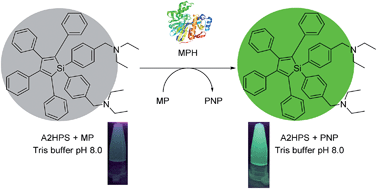A unique fluorescence response of hexaphenylsilole to methyl parathion hydrolase: a new signal generating system for the enzyme label†
Abstract
Methyl parathion hydrolase (MPH), an enzyme that catalyses the turnover of methyl parathion (MP) to p-nitrophenol (pNP), can be utilized as an enzyme label. In this paper, a unique fluorescence response of 1,1-bis[4-(diethylaminomethyl)phenyl]-2,3,4,5-tetraphenylsilole (A2HPS) to MPH whose gene was obtained from Pseudomonas sp. strain WBC-3 is described. In the absence of MP, A2HPS could only give a small fluorescence response to the enzyme (I/I0 = 1.1). The detection must be performed under low pH conditions, and the influence of BSA and hemoglobin (Hb) was high; upon addition of the enzyme's substrate, 1 × 10−5 μg mL−1 or 2.85 × 10−13 M of the MPH could be reported by A2HPS with a higher I/I0 of 1.7. The detection limit was 105 times more sensitive than that given by a spectrophotometric method. In addition, the assay could be performed at a near neutral pH which was more biocompatible, and little influence was observed from BSA and Hb. The light-on response to the MPH was due to the different quenching effect of the MP and pNP on A2HPS and the improvement in the detection selectivity was due to combining the enzyme reaction with the detection. The findings of this work suggested that A2HPS and MP could form a new reporter system for the MPH enzyme label.


 Please wait while we load your content...
Please wait while we load your content...